How to Start Catfish Farming in Nigeria 2024: Expert Guide
Catfish farming in Nigeria is one of the most popular and profitable agribusiness sectors.
This is because Catfish is a highly nutritious and delicious fish that is consumed by millions of Nigerians every week.
Catfish farming has many advantages, such as its adaptability to various climatic conditions, its resistance to diseases, its fast growth rate, and its high market demand.
In this blog post, we will discuss how to start catfish farming in Nigeria, how profitable it is, and what the costs involved.
Check out How to Start a Layer Poultry Farm
How Profitable is Catfish Farming in Nigeria?
Catfish farming is a very profitable business in Nigeria, as the demand for catfish is always high and the supply is low.
According to a report by the Food and Agriculture Organization (FAO), Nigeria is the largest producer of catfish in Africa, with an annual production of about 370,000 metric tons.
However, this is still far below the domestic demand, which is estimated at 2.1 million metric tons. This means that there is a huge gap between the supply and demand of catfish in Nigeria, which creates a lucrative opportunity for catfish farmers.
The profitability of catfish farming depends on several factors, such as the size of the farm, the quality of the fish, the cost of production, and the market price.
Generally, catfish farming has a high return on investment (ROI), as the fish can be sold at a good price after 4 to 6 months of rearing.
A catfish farmer can expect to make a profit of about 70% to 100% of the initial capital.
For example, if a catfish farmer invests N500,000 in setting up a catfish farm, he or she can expect to make a profit of N350,000 to N500,000 in 6 months.
Cost of Catfish Farming in Nigeria
The cost of catfish farming in Nigeria varies depending on the scale and type of the farm.
There are two main types of catfish farming systems: concrete tanks and earthen ponds.
- Concrete tanks are more expensive to construct and maintain, but they offer more control over the water quality, temperature, and hygiene.
- Earthen ponds are cheaper to construct and maintain, but they require more land and water, and they are more prone to predators and diseases.
The cost of catfish farming also depends on the cost of inputs, such as fingerlings, feed, medication, and labor. Fingerlings are the young catfish that are stocked on the farm.
The price of fingerlings depends on the size and quality of the fish. The average price of fingerlings in Nigeria is N20 to N30 per fish.
Feed is the most important and expensive input in catfish farming, as it accounts for about 60% to 70% of the total cost of production.
The price of feed depends on the type and quality of the feed. The average price of feed in Nigeria is N5,000 to N6,000 per 15kg bag.
Medication is used to prevent and treat diseases and parasites that may affect the catfish. The price of medication depends on the type and quantity of the drugs.
The average price of medication in Nigeria is N1,000 to N2,000 per month. Labor is the cost of hiring workers to help with the daily operations of the farm, such as feeding, cleaning, harvesting, and marketing.
The price of labor depends on the number and skill of the workers. The average price of labor in Nigeria is N10,000 to N15,000 per month per worker.
Based on these costs, the estimated cost of catfish farming in Nigeria for a small-scale farm of 1,000 fish is as follows:
| Item | Quantity | Price (N) | Total (N) |
| Concrete tank | 1 | 150,000 | 150,000 |
| Fingerlings | 1,000 | 25 | 25,000 |
| Feed | 10 bags | 5,500 | 55,000 |
| Medication | 6 months | 1,500 | 9,000 |
| Labor | 1 worker | 12,500 | 75,000 |
| Miscellaneous | – | – | 10,000 |
| Total | – | – | 324,000 |
Read also How to Grow Broiler Chickens Fast
How to Start Catfish Farming in Nigeria
Starting a catfish farming business in Nigeria requires some planning and preparation.
Here are the basic steps on how to start Catfish farming in Nigeria:
- Carry out a feasibility study. This involves researching the market demand, the competition, the potential customers, the suitable location, the legal requirements, and the financial projections of the catfish farming business.
- Get land and construct the farm. This involves finding a suitable site for the catfish farm, preferably near a water source, and constructing the tanks or ponds, the borehole, the drainage system, and the fence.
- Stock the farm with fingerlings. Source quality fingerlings from reputable hatcheries or suppliers, and stock them in the tanks or ponds at the appropriate density and ratio.
- Feed and manage the fish. This involves feeding the fish with nutritious and balanced feed, monitoring the water quality, temperature, and pH, and preventing and treating diseases and parasites.
- Harvest and market the fish. This involves harvesting the fish when they reach the desired weight and size, usually after 4 to 6 months, and selling them to customers, such as restaurants, hotels, bars, supermarkets, and individuals.
See also How to Start a Rabbit Farm
Conclusion on How to Start Catfish Farming in Nigeria
Catfish farming in Nigeria offers many benefits, such as high nutrition, high demand, high profit, and high employment.
Catfish farming is also a rewarding and enjoyable venture, as it provides a source of income and food security for many Nigerians.
However, catfish farming is not a get-rich-quick scheme, as it requires some investment, skills, and dedication.
To start and succeed in catfish farming in Nigeria, you need to conduct a feasibility study, acquire land and construct the farm, stock the farm with fingerlings, feed and manage the fish, and harvest and market the fish.
In this guide, we have discussed how profitable catfish farming in Nigeria is as well as how to start catfish farming in Nigeria.
We hope you find this blog post helpful. Don’t forget to share.
FAQs
How much does it cost to start a catfish farm in Nigeria?
The cost of starting a catfish farm in Nigeria depends on the scale and type of the farm. A small-scale catfish farm of 1,000 fish can cost about N324,000, while a large-scale catfish farm of 10,000 fish can cost about N3,240,000.
How long does it take to grow catfish in Nigeria?
The growth rate of catfish in Nigeria depends on the species, the feed, the water quality, and the management. Generally, catfish can reach a marketable weight of 1 to 1.5 kg in 4 to 6 months.
How much can I make from catfish farming in Nigeria?
The income from catfish farming in Nigeria depends on the market price and the expenses.
Generally, catfish farming has a high return on investment (ROI), as the fish can be sold at a good price after 4 to 6 months of rearing.
A catfish farmer can expect to make a profit of about 70% to 100% of the initial capital.
What are the challenges and risks of catfish farming in Nigeria?
Some of the challenges and risks of catfish farming in Nigeria are:
- High cost of feed and other inputs, such as fingerlings, medication, and labor.
- Low quality of fingerlings and feed, which may affect the growth and health of the fish.
- Predators and thieves may attack or steal the fish.
- Diseases and parasites may infect or kill the fish.
- Environmental factors, such as floods, droughts, pollution, and climate change, may affect water availability and quality.
- Market fluctuations may affect the demand and price of the fish.

